Texture refers to the quality or nature of a surface. Any surface. The texture of a marble sculpture might be described as smooth and voluptuous. A china plate has a hard and shiny texture that repels water. A lake might be as smooth as glass one day, and choppy the next. A woven fabric can be nubby and open textured, or silky. This farfugium leaf is a study in contrasting textures. The body of the leaf is smooth to the touch, and strikingly veined and shiny to the eye. The edges of the leaves are markedly ruffled; the leaf edges are sharp. Were I ever to eat farfugium, I imagine its texture would be juicy and crunchy.
Texture engages the senses. You can see a surface. This panic grass is primarily and busily vertical, with an occasional and beautifully draping stem. You can feel the surface. Ornamental grass leaves can cut your hands-the edges of the blades are sharp! Feeling that texture can be irritating. Animals who eat grass-who knows how they would describe the texture. I would guess it is chewy and stringy. Raw carrots are as remarkable for their crunch as much as their taste. Oysters and okra are slick, and slide down easily. Bread can be doughy, or dense. Or light, as in a souffle. Texture can be tasted. It can be seen. It can be felt. Heavy clay soil can be greasy. Sandy soil is gritty. Soil loaded with compost has such texture that air has an easy time finding a home in it. I cannot imagine how many adjectives exist to describe various surfaces-it would be a daunting task to make a list.
Suffice it to say that there are a multitude of utterly unique and enchanting textures in plants. Salvia argentea is notable for its felted leaves. It is the devil to grow, but its surface, its texture, is utterly unique. I have no luck with this plant in the ground, and only sporadic luck with it in containers, but I keep trying. The texture of the leaves reminds me of fur and felt both.
This pilea involucrata “Moon Valley” is noted for its markedly fissured leaves. The leaf is rough to the touch. It is interesting to the eye. Designing a container, or a garden, or a landscape, asks for all kinds of attention beyond the horticulture. The design details can endow a planting with a special beauty. There is color to contend with. There is volume and mass. There is line, and form. And there is texture.
I do not grow vegetables to eat. But I do grow them to look at. This ruffly leaf lettuce satisfies my eye’s demand for interesting texture, just as much as I admire the color.
Selaginella, or club moss, has dimuitive leaves. I would say it is very textural-the surface is lively. But given that it is a very small plant that hugs the surface of the soil, I would describe its texture as densely uniform. The idea here? Small leaves have an entirely different texture than big ones. The relationship of one texture to another adds another layer of interest to any planting.
On a stormy night, my boxwood read as a mass-the individual texture of all of those individual leaves is not so apparent. The roses are a lot of fluff, a lot of stalky canes-the blooms are soft to the touch. The roof is smooth from this distance; the clouds have a lot of color, a little bit of volume, and a weighless appearance. Many textures are apparent here. The relationship of one textural element to another is what makes for a design party.
A lanmdscape is comprised of many different elements-each of these elements have a surface and texture all their own. The relationship between distinctive and individual surfaces is what insures an enduring visual interest in a landscape.
Every surface here is hard-as in impermeable, or shiny. The textures are smooth and uniform. My client is asking-what would you do here? Perhaps, a contrasting texture!
This essay was written in conjunction with all of the other members of the Garden Designer’s Roundtable-be sure to check out all of their postings!
Thomas Rainer : Grounded Design : Washington, D.C.
Rebecca Sweet : Gossip In The Garden : Los Altos, CA
Pam Penick : Digging : Austin, TX
Lesley Hegarty & Robert Webber : Hegarty Webber Partnership : Bristol, UK
Douglas Owens-Pike : Energyscapes : Minneapolis, MN
David Cristiani : The Desert Edge : Albuquerque, NM

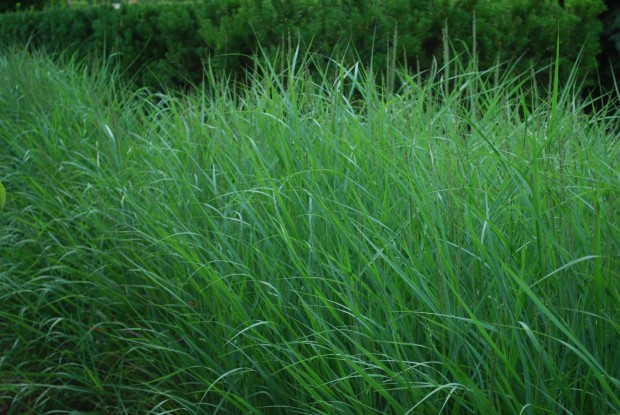
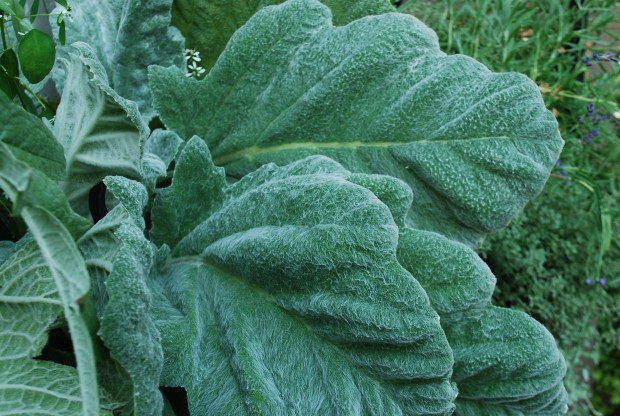
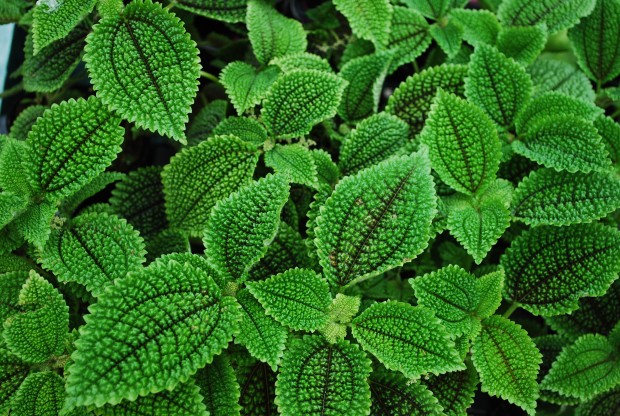
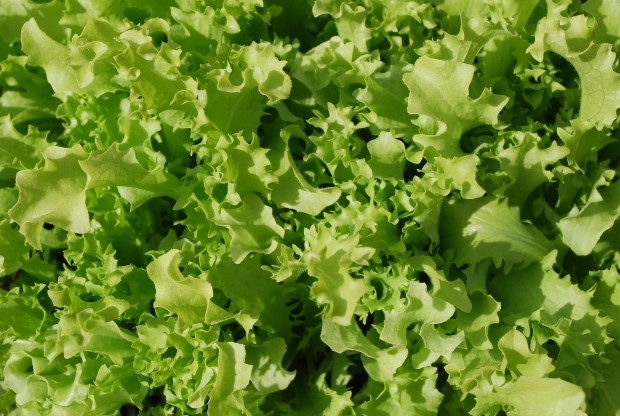


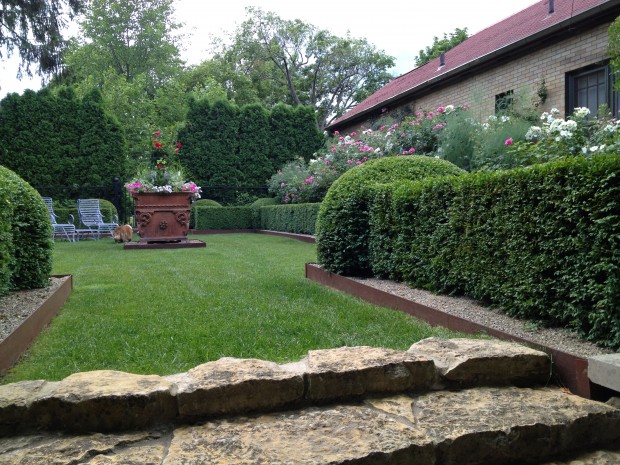
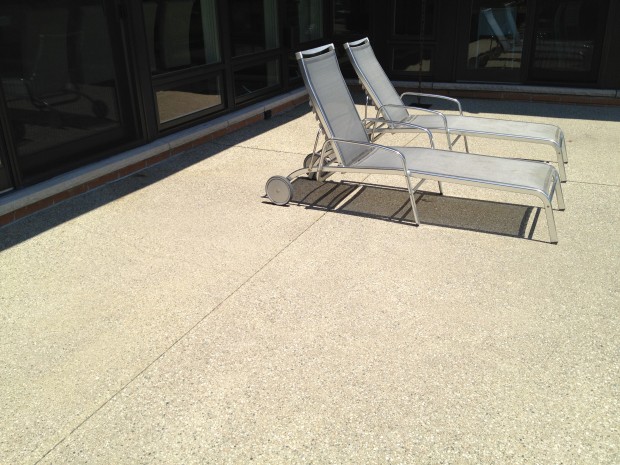
 Texture is such an exciting element in plants-and plantings. Defined by Wikipedia as “an identifying quality”, or the “appearance and feel of a surface”, the texture of a plant can be about its appearance. Some plants are shiny leaved; some have felted leaves. Some leaves and flowers are thin (sometimes referred to as “substance”) and some are thick and juicy looking. Some leaves are wisy and airy looking-others are big and broad-and look as though even a big wind wouldn’t disturb them. This kale is ultra-crinkled-beautiful.
Texture is such an exciting element in plants-and plantings. Defined by Wikipedia as “an identifying quality”, or the “appearance and feel of a surface”, the texture of a plant can be about its appearance. Some plants are shiny leaved; some have felted leaves. Some leaves and flowers are thin (sometimes referred to as “substance”) and some are thick and juicy looking. Some leaves are wisy and airy looking-others are big and broad-and look as though even a big wind wouldn’t disturb them. This kale is ultra-crinkled-beautiful.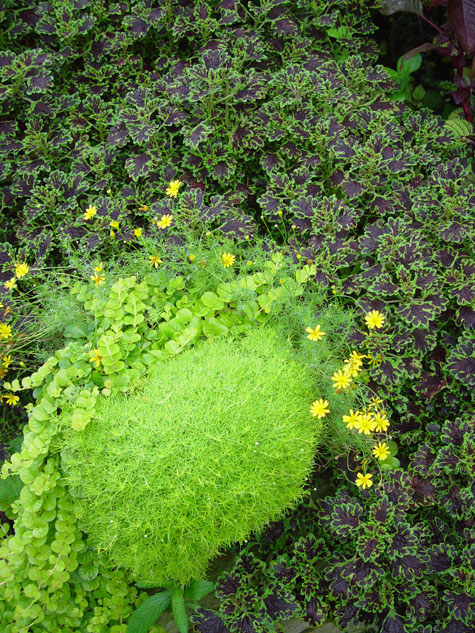 Texture can also refer to how a plant feels to the touch-who could resist touching this scotch moss? Contrasting textures can make for a lot of excitement in a planting-but even the relationship of one small texture to another can be interesting.
Texture can also refer to how a plant feels to the touch-who could resist touching this scotch moss? Contrasting textures can make for a lot of excitement in a planting-but even the relationship of one small texture to another can be interesting.  Some plantings where all the textures read similarly encourage focus on color, or mass. The choice of plants very much dictates what about a plant or planting becomes the dominant element. This box of grass, euphorbia Diamond Frost, thyme and sedum has that casual roadside weed look to it. You notice the blue of the sedum first off, as the textures of all the plants are so similar. There is a whole story here about little leaves.
Some plantings where all the textures read similarly encourage focus on color, or mass. The choice of plants very much dictates what about a plant or planting becomes the dominant element. This box of grass, euphorbia Diamond Frost, thyme and sedum has that casual roadside weed look to it. You notice the blue of the sedum first off, as the textures of all the plants are so similar. There is a whole story here about little leaves. 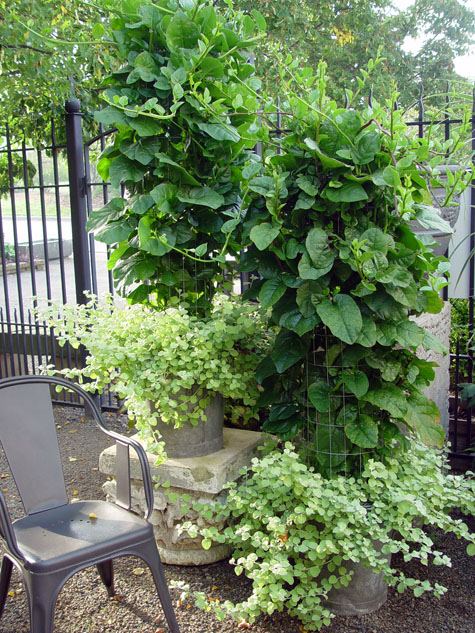 Malabar spinach has thick, substantial leaves that are glossy and wrinkled. This texture reads all the more strongly for its pairing with the diminuitive felted stems and leaves of lime licorice.
Malabar spinach has thick, substantial leaves that are glossy and wrinkled. This texture reads all the more strongly for its pairing with the diminuitive felted stems and leaves of lime licorice. 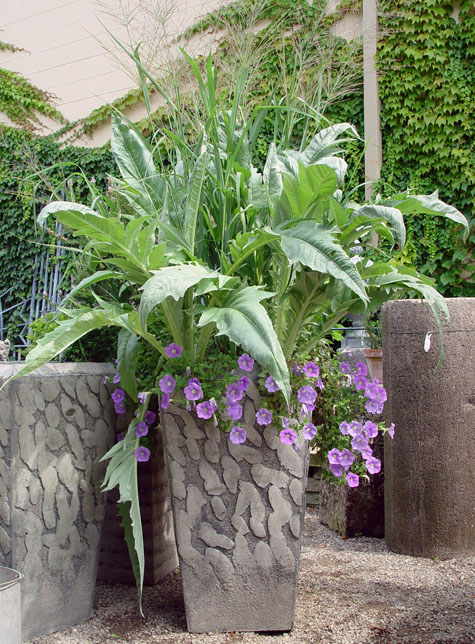 The hunky, toothy, slighting menacing leaves of this cardoon are softened by the much less architectural “Dallas Blues” panicum grass-and the so sweet blue petunias. The cardoon has a felted leaf-the panic grass is smooth and shiny. Those blue petunias are along for the ride-and soften much the architecture of the cardoon-and the pot.
The hunky, toothy, slighting menacing leaves of this cardoon are softened by the much less architectural “Dallas Blues” panicum grass-and the so sweet blue petunias. The cardoon has a felted leaf-the panic grass is smooth and shiny. Those blue petunias are along for the ride-and soften much the architecture of the cardoon-and the pot.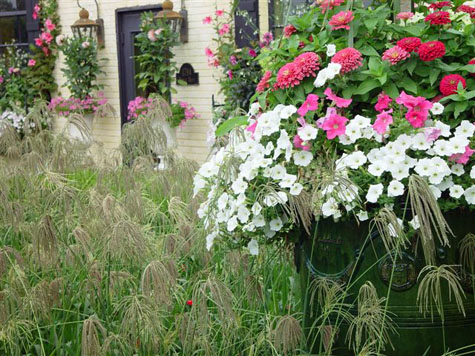 Large flowers like zinnias and petunias have a simple texture, while its companion grass has a complex, texture-like fireworks. Diametrically opposed to this delicately textured grass, caladiums and this lime dieffenbachia have leaves so thin and so wide the sun shines through them; it looks like the lights are on in this very shady spot. Identifying what about a particular plant you like will help a lot to inform your design with them. Everyone knows texture. Its the process of being conscious of it that can help make for inspired plantings .
Large flowers like zinnias and petunias have a simple texture, while its companion grass has a complex, texture-like fireworks. Diametrically opposed to this delicately textured grass, caladiums and this lime dieffenbachia have leaves so thin and so wide the sun shines through them; it looks like the lights are on in this very shady spot. Identifying what about a particular plant you like will help a lot to inform your design with them. Everyone knows texture. Its the process of being conscious of it that can help make for inspired plantings .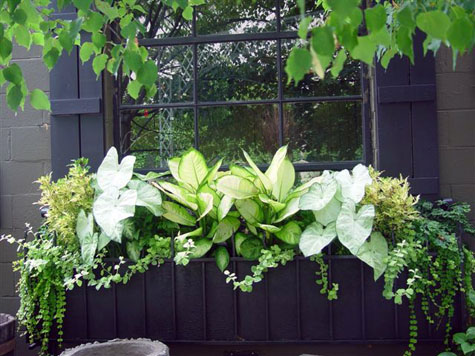
 If all the color of my past few posts has put you on overload, perhaps these pots will suit you better. As I have said, annual plants are those plants that survive but one season-this is a large group-some of which have no flowers of consequence.
If all the color of my past few posts has put you on overload, perhaps these pots will suit you better. As I have said, annual plants are those plants that survive but one season-this is a large group-some of which have no flowers of consequence. Annual plantings or pots without flowers can be very effective and attractive. Some locations for annuals do not have enough sun to support good flower production. Annual plants can be as much about their forms, their leaves, and their architecture, as they are about flowers. This very tall “elegant feather” plant-no longer in production at Proven Winners, is a great foil for the round-leaved farfugiums. There are very few greens I do not like. My yews go black green in the winter when it is really cold, much like this Moses in the Cradle. The chartreuse and yellow coleus “Wild Lime” provides lots of punch in shade.
Annual plantings or pots without flowers can be very effective and attractive. Some locations for annuals do not have enough sun to support good flower production. Annual plants can be as much about their forms, their leaves, and their architecture, as they are about flowers. This very tall “elegant feather” plant-no longer in production at Proven Winners, is a great foil for the round-leaved farfugiums. There are very few greens I do not like. My yews go black green in the winter when it is really cold, much like this Moses in the Cradle. The chartreuse and yellow coleus “Wild Lime” provides lots of punch in shade.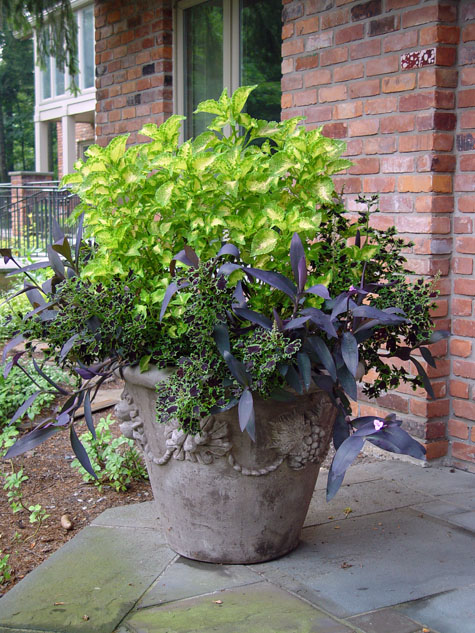 Chartreuse green is spring like, and fresh, no matter what time of year I see it.Grass after an electrical storm is so intensely dark gorgeous green-thus the term grass green. Lime creeping jenny is a versatile plant that highlights darker plants and obligingly trails.
Chartreuse green is spring like, and fresh, no matter what time of year I see it.Grass after an electrical storm is so intensely dark gorgeous green-thus the term grass green. Lime creeping jenny is a versatile plant that highlights darker plants and obligingly trails. 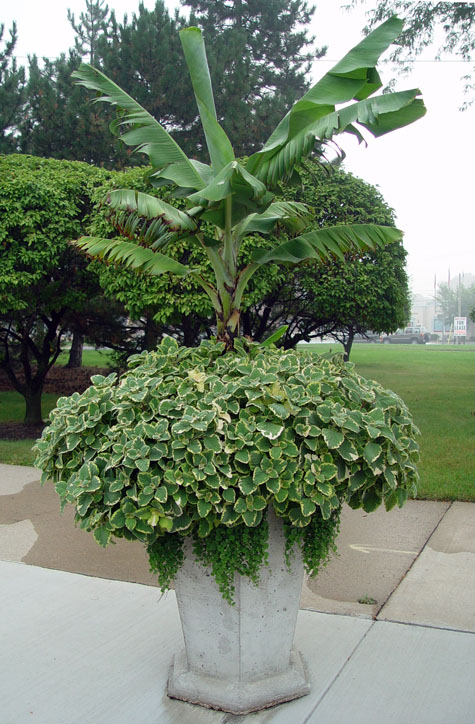 Green can be as much about texture and scale, as color. The slick, massive texture of this banana is complimented by the thick felted leaves of this variegated Plectranthus.
Green can be as much about texture and scale, as color. The slick, massive texture of this banana is complimented by the thick felted leaves of this variegated Plectranthus. Caladiums, calocasias, and cannas have spectacularly large foliage.
Caladiums, calocasias, and cannas have spectacularly large foliage. 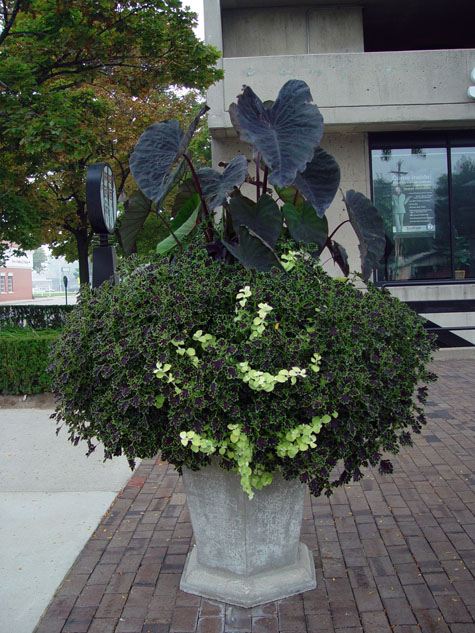 Calocasias and caladiums are thin-leaved (this refers to their “substance”); light will shine through them. Helicrysum both in lime and variegated leaf are densely felted.
Calocasias and caladiums are thin-leaved (this refers to their “substance”); light will shine through them. Helicrysum both in lime and variegated leaf are densely felted. 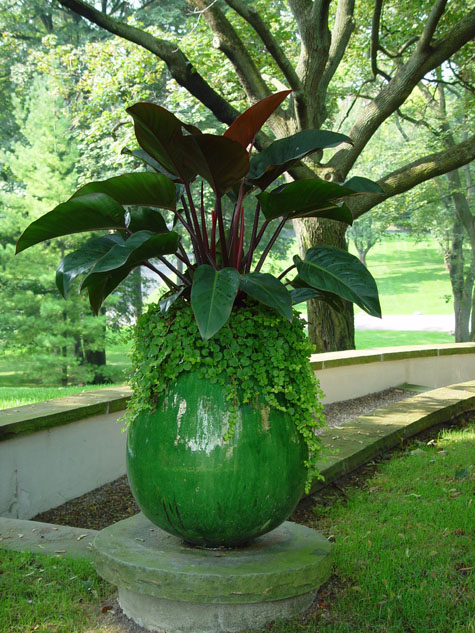
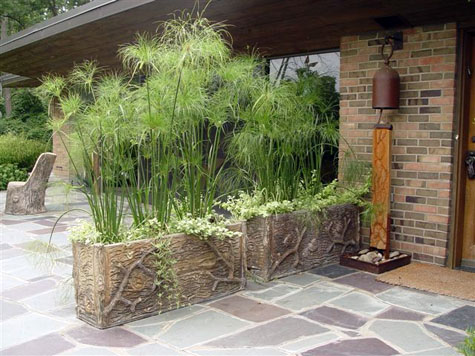
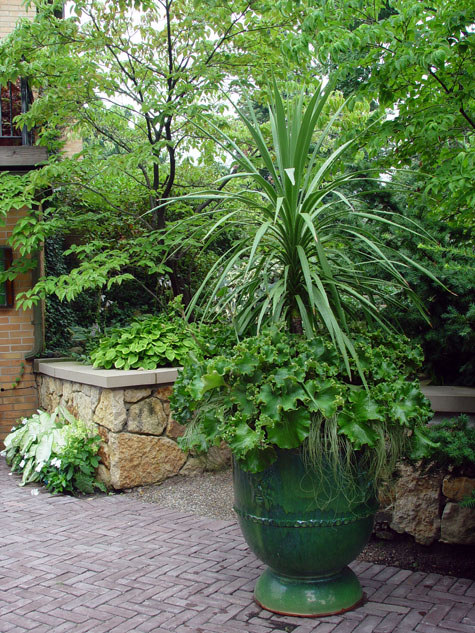 Phormiums, and dracaenas are stiff-strapped, and sword-like-an interesting contrast to this curly leaved farfugium. Cycads and escheverias have that dense waxy texture, and can be rounded, or spiky.
Phormiums, and dracaenas are stiff-strapped, and sword-like-an interesting contrast to this curly leaved farfugium. Cycads and escheverias have that dense waxy texture, and can be rounded, or spiky.
 Tuscan blue kale has great size, a blistered leaf surface, and a very blue color-just the thing to pair with a blue juniper column, variegated licorice, and ornamental oregano “Kent Beauty” .
Tuscan blue kale has great size, a blistered leaf surface, and a very blue color-just the thing to pair with a blue juniper column, variegated licorice, and ornamental oregano “Kent Beauty” .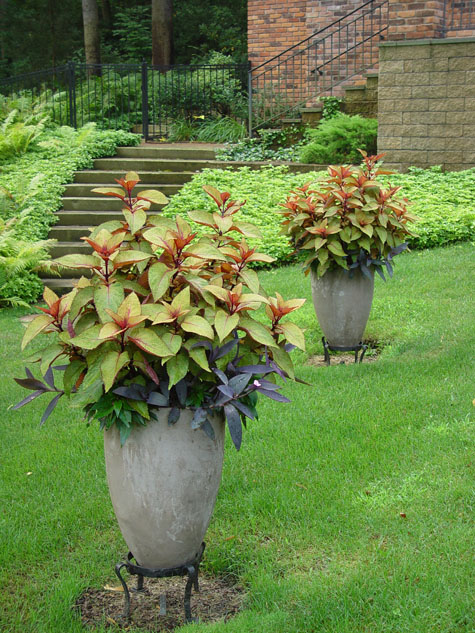 One of my favorite coleus is a yellow/olive color I call turtle green. The striped grass, miscanthus zebrina, is a happy companion to a plectranthus with the same color variation. The third element: the pairing of the plant material is complimented by the pairing of the pots close enough to encourage all the plectranthus to grow together.
One of my favorite coleus is a yellow/olive color I call turtle green. The striped grass, miscanthus zebrina, is a happy companion to a plectranthus with the same color variation. The third element: the pairing of the plant material is complimented by the pairing of the pots close enough to encourage all the plectranthus to grow together. So many beautiful greens. So many ways in which green is beautiful.
So many beautiful greens. So many ways in which green is beautiful.